“Her toils are past, her apricots down, her scurvy and her love,” Robert Sweetman reads. “No, that can’t be right.” He kneels before the lichen-covered grave in Provincetown’s Old Alden Street Cemetery and gets to work.
First, he sprays the marble gravestone with water from a handheld pressure pump. Then, using another pressure pump, he hits it with a solution of water and Orvus, an extremely gentle multipurpose soap that’s often used to wash animals. It’s the same substance the Smithsonian Institution uses to clean historic monuments.
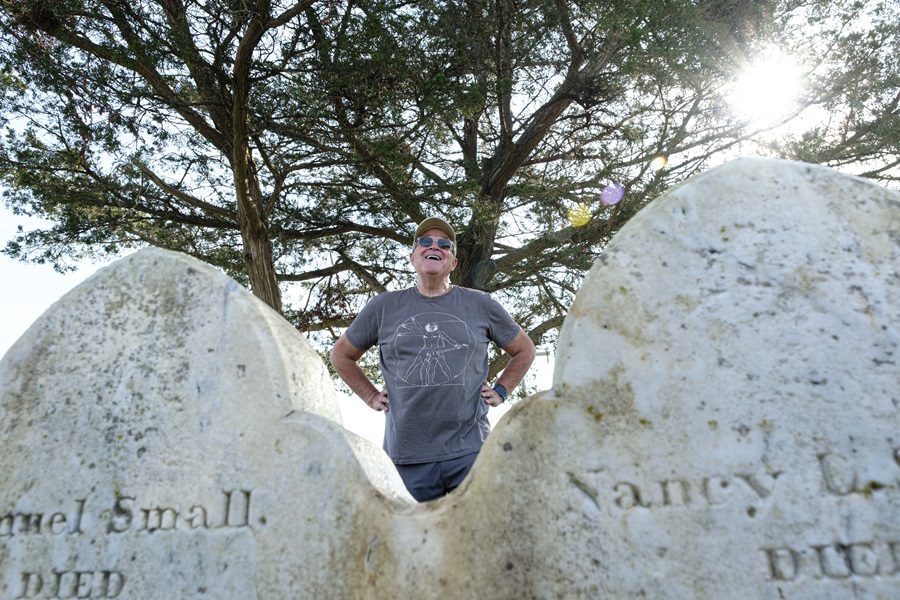
Sweetman uses a series of brushes to scrub the soapy headstone. Some are broad, the kind you’d use to clean a horse; others look like toothbrushes.
After rinsing away the Orvus, Sweetman uses D/2 Biological Solution to remove any remaining grime. The solution, often used by conservators, separates biological organisms like lichens from the stone. Sweetman says that the National Cemetery in Arlington, Va. sprays the gravestones there with D/2 periodically to remove stains, though they don’t usually bother scrubbing the way he does. He lets the D/2 sit for a little while before rinsing it away.
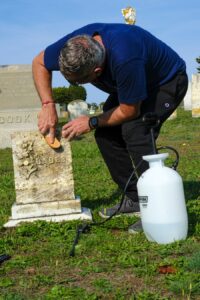
Sweetman is the chair of Provincetown’s cemetery commission, which means he’s in charge of managing the deeds to the lots in the cemeteries. He isn’t usually the one who mows the grass around the graves (that’s the DPW) or polishes them (that’s a private contractor), but Sweetman has learned that keeping a cemetery clean isn’t cheap. He says the average cost to clean a single gravestone is between $50 and $80, and the town can spend as much as $8,000 for a round of touch-ups.
So, he learned to do the work himself. Sweetman signed up for a grave-cleaning workshop given by a specialist in the spring of 2023 at a Wellfleet cemetery. The towns sending cemetery commissioners paid a collective $1,000 for the one-day class, but Sweetman figured it would save him money in the long run.
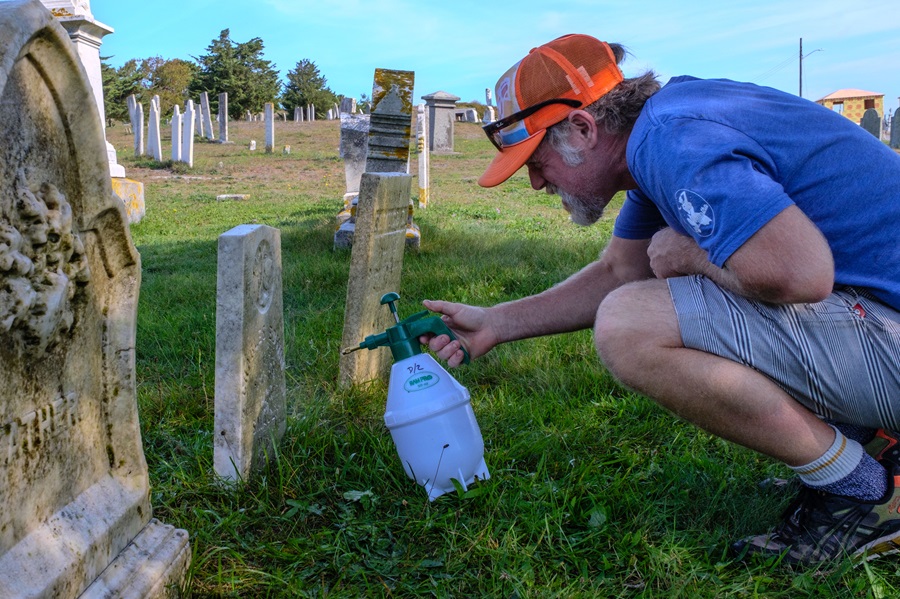
The problem is that Sweetman is only one person, and there are some 3,500 graves in the town’s cemeteries. Though not each one has its own stone, there are certainly too many stones for him to clean by himself. That’s why he held a community gravestone cleaning session on Oct. 4. It was his experiment to see if others would pitch in, and Sweetman says it was a success. He says he expected three or four people to show up. Instead, he got 10. He was worried about spending a few hundred dollars for all the supplies, he says, but they can be stored for future cleaning sessions.
There are rules for cleaning gravestones, and Sweetman doesn’t want people going out to do this without supervision. One rule is never to use a metal brush because it can leave scratches on soft stone like marble. (Sweetman recommends using bamboo dowels instead to clean hard-to-reach areas.) Make sure you know what the headstone is made of, because slate tends to erode when rubbed too hard. And never hold on to the headstone while you’re standing up after you’re done lest it fall over.
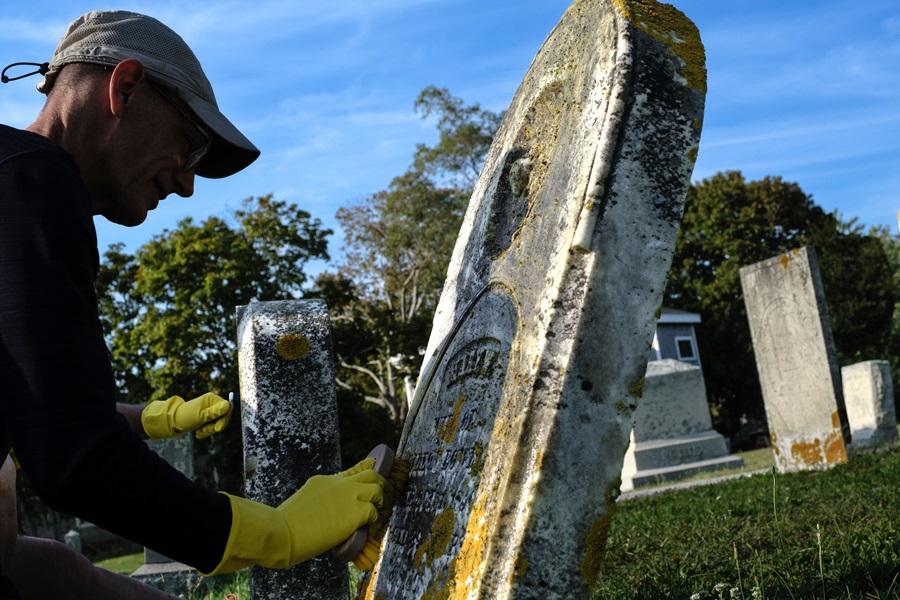
The inscription on the headstone Sweetman is cleaning — now running a temporary pinkish-orange as the lichens react to the D/2 — is much clearer now: “Her toils are past, her work is done; her weary soul has found its rest,” he reads. Sweetman steps back to admire his work. This stone marks the grave of Ruth Snow, who died in 1865, and it’s legible for the first time in perhaps a century.
That’s because headstone cleaning isn’t something the cemetery promises. When families buy a plot, they pay two fees up front: one for the initial burial and another for maintenance in case the stone needs to be repaired. But there’s no agreement on cleaning the stones. “They just sit there,” Sweetman says, unless someone decides to clean them.
But because their inscriptions reveal stories, there’s immense satisfaction in cleaning an illegible headstone. “There are so many of these stories that are untold,” Sweetman says. “You could just walk by them and ignore them, but cleaning them makes me want to investigate.”
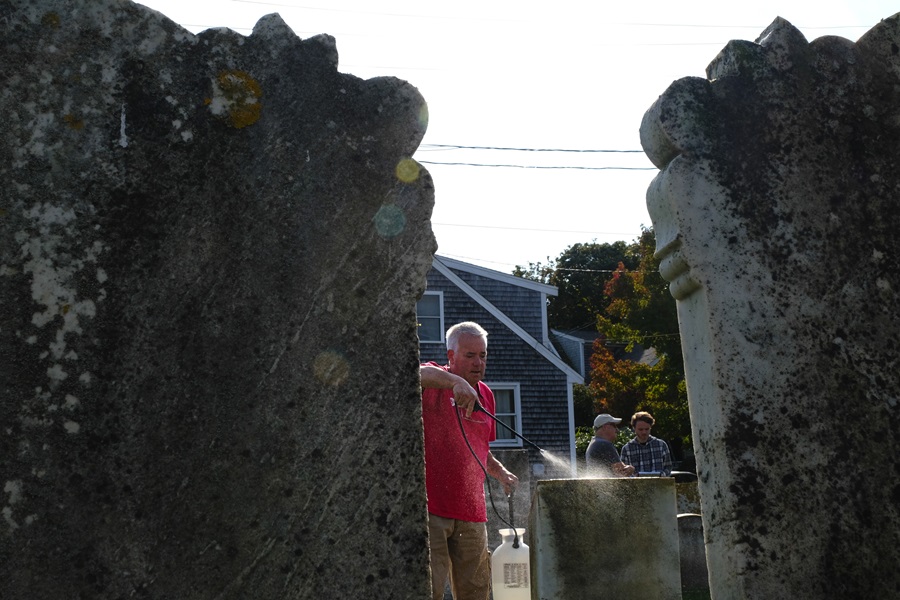
Sweetman hopes that his interest in local history will catch on. He’s working to compile a digital guide to the cemetery that will allow visitors to easily search for graves of the writers, artists, seafarers, and others buried in it and read stories about their lives.
“There are all sorts of famous folks here,” Sweetman says. Take Ann Maguire, for instance, an LGBTQ activist and breast cancer survivor who was buried in this cemetery after her death last December. Sweetman likes the idea of adding people like Maguire to an online brochure, something he can’t do with the cemetery’s current physical one.
By the end of Sweetman’s headstone cleaning session the team had visited 25 graves, a hundredth of the total. The other 99 percent will have to wait. Because D/2 works only when the temperature is above 50° F, Sweetman doesn’t plan on hosting another session until the spring. Until then, the headstones will stand like rows of crooked teeth, patiently awaiting their next checkup.
